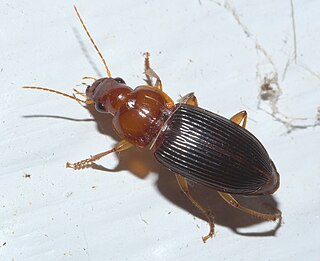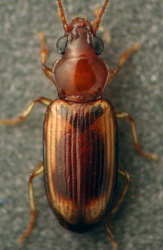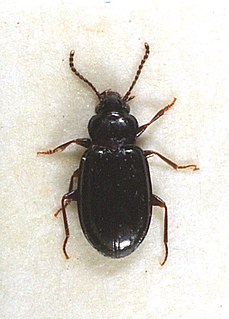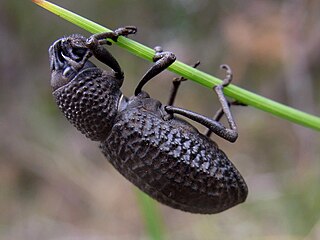
Ant spiders are members of the family Zodariidae. They are small to medium-sized eight-eyed spiders found in all tropical and subtropical regions of South America, Africa, Madagascar, Australia-New Guinea, New Zealand, Arabia and the Indian subcontinent. Most species are daytime hunters and live together with ants, mimicking their behavior and sometimes even their chemical traits. Although little is known about most zodariids, members of the genus Zodarion apparently feed only on ants; a number of other genera in the family are apparently also ant specialists.

Harpalinae is a huge subfamily of ground beetles that contains 20,000 species or ~6,400 spp. in 24 tribes worldwide, according to others. A rarely used common name for the subfamily is the harp beetles. The Harpalinae contain the most apomorphic ground beetles, displaying a wide range of forms and behaviors. Some are, rare among ground beetles, omnivores or even herbivores.

The big free-tailed bat is a bat species found in South, North and Central America, as well as the Caribbean.

Helotidae is a family of beetles, in the suborder Polyphaga. The family includes about five extant genera, Helota MacLeay, Neohelota Ohta, Afrohelotina Kirejtshuk, Metahelotella Kirejtshuk, and Strophohelota Kirejtshuk. Helotidae are found mainly in the Old World tropics and are absent from Australia and Madagascar. The antennae are clubbed on the final three segments and is retractable within grooves under the head. The wings have reduced venation with just 4 anal veins.
Pogonoglossus is a genus of beetles in the family Carabidae, containing the following species:
Gnathoxys is a genus of beetles in the family Carabidae, containing the following species:
Planetes is a genus of beetles in the family Carabidae, containing the following species:

Notiobia is a genus of ground beetles in the family Carabidae. There are at least 90 described species in Notiobia.

Lebiinae is a subfamily of beetles in the family Carabidae.

Pericalus is a genus of beetles in the family Carabidae, containing the following species:

Platyninae is a subfamily of ground beetles. Occasionally it was treated as a tribe Platynini of subfamily Harpalinae, particularly when this was circumscribed loosely.

Scaritinae is a subfamily of beetles in the family Carabidae, containing the following genera:

Trechinae is a subfamily in the ground beetle family, Carabidae.

Pericompsus is a genus of ground beetles in the family Carabidae. There are more than 70 described species in Pericompsus.

Tachyta is a genus of ground beetles in the family Carabidae. There are at least 30 described species in Tachyta.

Nops is a genus of medium-sized South American, Central American, and Caribbean spiders in the family Caponiidae, first described by Alexander Macleay in 1839. It has a great richness on the Caribbean islands, and most mainland species are located in high proportion toward the Caribbean coast. It likely has a neotropical distribution, though most species of South America are known only from the coast of Colombia and Venezuela, including the islands of Aruba, Curaçao, Bonaire and Trinidad.
Carenum coracinum is a species of ground beetle in the subfamily Scaritinae. It was described by William John Macleay in 1865.

Bembidiini is a tribe of ground beetles in the family Carabidae. There are more than 120 genera and 1,200 described species in Bembidiini.

Talaurinus is a genus of weevils belonging to the family Curculionidae. The species of this genus are found in Australia. The genus first appeared in scientific literature in the Transactions of the Entomological Society of New South Wales, published by William MacLeay in 1865.














